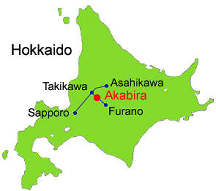|
Utashinai, Hokkaido |
Index Page Hakodate Overview
|
Location: HOKKAIDO, SORACHI-gun, UTASHINAI-machi, AZA TOKO Satellite map Aerial (Jun. 1948; courtesy of Japan Map Archives) Area map Time Line: 5 July 1945: First occupied by Americans arriving from China. 28 Aug 1945: First food drops by B-29's 17 Sept 1945: POWS departed camp after RAMP team arrived on 11 Sept 1945 Description: Situated on the bank of a small stream in a 200-yard-wide valley. Camp was enclosed within 10 foot high wooden walls. Southwest of camp was the Korean barracks, due west was a power station. Winter snowfall averaged over six feet in December and January but no POWS arrived before July of 1945.  History of Hakodate Camps Camp Layout: Compound was 300 feet long, Barracks had three, two level sections. Each section was 15 by 23 feet while the upper decks were 8 by 15 feet. Each section contained 40 men. Toilet building, with 10 stalls, located adjacent to barracks. Two other buildings in one corner of compound served as the Japanese barracks and administrative office. Directly opposite was a long building that was the galley, storeroom and bathhouse. Japanese Camp Staff: [partial] Camp Commandant: Lt Kinsbuho Niizuma Mess officer: Kenichi Kikuchi - sadistic, hated white people, stole supplies regularly. Interpreter: Takeda (a bastard) replaced by- Interpreter: Hisao Kawasaki - very reasonable Medical: Cpl Unesaku Nakao - "unsavory" - constant interference with American doctor. Guard: Sr Pvt Takahashi - sadistic and brutal Civilian Supply Officer: Sataro Tateda - cooperative and friendly Photos: Coal Mine historical photo 1 - photo 2 |
Primary Labor Use: Slave labors in the coal mines of the Hokkaido Coal Mining Company which controlled all mines in the Akabira area. The mines in the area of Camp #3 Utashinai were operated by a branch company called Sorachi Mining Company. Koreans worked two mines while POWS operated a third drift mine. The "Mojiri Mines" closed in 1994. Camp Rosters at Liberation: Total = 311 POWs (284 American, 26 British, 1 South African) US and British Partial roster based upon Wake Rosters and USMC Historical Center See Hakodate Overview for archival originals of rosters. Books Describing Life at Hakodate #3: Biggs, Chester M. Jr, Behind the Barbed Wire, McFarland & Co, Jefferson, NC, 1995. PFC Jesse E. Nowlin, USMC, 1st Defense Battalion, Wake Island Motorcyle Marine (info courtesy of Jack Sands, former SSgt, USMC) "Here is a photo of PFC Jesse E.
Nowlin, a Texan, who joined the Marine Corps on June 26, 1940. In
December, 1941, he was serving with the 1st Defense Bn. on Wake
Island. One of his duties involved riding a sidecar equipped
motorcycle. Following the battle, he was captured and served the rest
of the war as a POW of the Japanese. After the war, he graduated
from North Texas State University and pursued a career in mechanical
engineering. He was employed by the U.S. Chemical Corp, the Atomic
Energy Commission, and the Small Business Administration. He died
on September 13, 1990, in Dallas, Texas, at the age of 74. He was
buried with full military honors at Willow Wild Cemetery, Fannin Co.,
Texas.
"Other Marines on Wake, whose duties involved riding the three motorcycles available, were Herman L. Rasor, who served in the Corps from June 1941 to April 1962, and another career Marine named James R. Brown, who often transported the mail sergeant to meet the Pan American Clipper. He retired as a captain. "Ernest G. Rogers, one of the Army Air Corps soldiers on Wake, observed a humorous incident after the occupation. He saw a Japanese soldier, who was obviously unfamiliar with the heavy sidecar equipped American motorcycles, attempt to ride one. He got the motorcycle started and shifted in to low gear and as it moved forward slowly, he shifted again, but by mistake into reverse. As the machine jerked backwards, the soldier was thrown over the handlebars and landed on the ground. He then ran after it and eventually was able to climb aboard, shift into low gear and ride away very slowly. "The American captives were loaded aboard the Japanese liner, Nitta Maru and taken to POW camps. According to Colonel Hiromichi Muromoto of the Japan Ground Self-Defense Force (JGSDF), who was assigned to the Japanese Embassy in Washington in the early 1980s, the ship was later converted to an aircraft carrier named Chuyoh. On December 3, 1943, while enroute to Yukusaka, she was torpedoed by an American submarine off Hachijo-Jima Island. It sank the following day. "American forces successfully blockaded the island and a large number of Japanese occupiers starved. One of those who starved to death, kept a diary that was later found. His name was Lance Corporal Watanabe Mitsumasa of the Anti-Tank Co., 1st Bn, 13th Mixed Independent Regt. His entry for April 21, 1944 read, 'No ships come here anymore. We are disappointed. Today had a meal of roasted rat. I dined with good appetite; perhaps it will give me energy.' (Reference for the diary info: History of Wake Island 1568-1946, by Capt. E. A. Junghans, USN. Mimeographed copy from HQ USAF Code PRPJ)." |